|
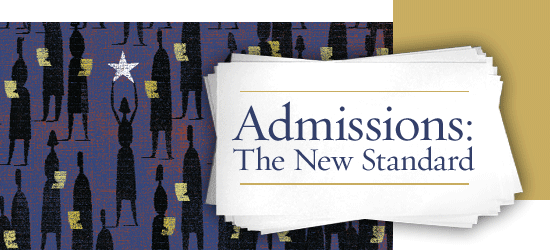
By Jamie L. Freedman
Illustrations by Jim Frazier
It’s a daunting task. Each year, as Thanksgiving nears, stacks and stacks of GW Law School applications pour into the Admissions Office—and the tidal wave continues straight through the spring. This past year, GW Law received a record-breaking 11,687 applications—913 more than last year. In fact, recent statistics reveal that nationwide, more than one out of every eight people considering law school applies to GW.
The question, then, is, how can GW Law’s admissions staff most effectively plow through the veritable mountain of applications, secure in the knowledge that they are filling the Law School’s limited number of seats with the highest quality group of incoming students?
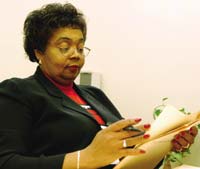 |
|
Josie Shelby-Wilson is the Law School’s director of admissions.
Photo by: Claire Duggan
|
The answer, quite simply: “One at a time,” says Bob Stanek, JD ’71, associate dean for admissions and financial aid, who has overseen the process for the past 29 years. The official “first read” on every applicant, Stanek routinely takes piles of applications home with him every weekend from November through May. “There’s no other way to do it,” he says. “My feeling is that these kids are paying us $70 for a fair decision, and the only way to guarantee them that fair decision is by giving each and every one of them an equal read.”
Stanek’s three decades of experience provide him with a unique vantage point from which to evaluate the annual pool of candidates. “Because I’ve seen so many applications over the years, I’ve become quite adept at reading them and getting a quick sense of the strength of the students’ undergraduate curricula and the quality of their personal statements,” he says. “I vote based on factors that all the applicants share, such as academic records, LSAT scores, writing skills, and recommendations.” While Stanek accepts top candidates and rejects the weakest ones during this early stage of the process, he passes stacks of less clear-cut cases on to the GW Law Faculty Admissions Committee for closer review. The dedicated committee members, including law professors Greg Maggs, Peter H. Meyers, and Joan Schaffner, as well as GW Law Director of Admissions JoSie Shelby-Wilson, thoroughly evaluate each file.
“Committee members each get one vote, and when there are questions about a candidate, a majority vote of the committee is required for an applicant to be admitted,” says Stanek. The committee members, who, like Stanek, haul applications from office to home and back again for many months of the year, spend countless hours reviewing prospective students on an individual, case-by-case basis.
“We take a careful look at those borderline cases who may not have come first in their class or scored in the 99th percentile on the LSAT, but who still deserve our consideration,” says Professor of Clinical Law Peter H. Meyers, who has served on the committee for the past two years. “We look at their applications, their college transcripts, their essays to see how they write, and their reference letters. I don’t only consider the numbers or use a specific formula. I can be impressed by the fact that a candidate overcame a serious illness or great obstacle in life, or by someone’s work experience or idealism. If a candidate has an exceptional background that shows both an ability to do the work and a striving for and succeeding at excellence, they deserve a chance to come to GW Law.”
| The 2003 Entering Class |
|
Where Are They From?
|
USA (43 states)
Bahamas
Bulgaria
Canada
Korea
Russia
|
 |
|
|
Total Applications Received
|
11,687
|
| Students Admitted |
2,090
|
|
Students Enrolled
(57% male, 43% female)
|
536
|
|
Median Undergraduate GPAs
|
3.42
|
|
Median Undergraduate LSATs
|
164
|
|
Minority Students Enrolled
(57% male, 43% female)
- Asian American students
- Hispanic students
- African American students
- American Indian students
|
168
66
49
47
6
|
|
Professor of Law Greg Maggs, a member of the committee since 1993, emphasizes the importance of evaluating candidates based on their whole file. Maggs, who states that admissions files have been “a fixture of my life for the past 10 years,” explains, “I look very carefully at the courses that students took to ensure that they had a rigorous undergraduate curriculum, as well as at their grades and LSAT scores. Beyond that, I read the personal statements very carefully, since there are no two identical candidates. Everyone is an individual. Many of our applicants are spectacularly interesting, and you need to read the statements to find out who they are.”
Maggs, who estimates that he takes home some 30 files a week to review, admits that it’s extremely difficult to compare candidates. “I wish there was an easy formula, but every decision is hard,” he says. “I make the determination as I see it, and the one saving grace is that candidates generally apply to a number of law schools, so if we fail to see something in an applicant, hopefully another school will.”
Associate Professor of Law Joan Schaffner, the most recent addition to the committee, agrees. “We tend to see more of the swing candidates—those who are not clearly slam dunk in or out,” she says. “It’s obviously difficult when you just have a paper record to go by, as opposed to a personal interview, but we do our best to examine all of the factors and make the best possible decisions. The admissions process is critically important, as our incoming student base defines our law school.”
Schaffner says that the Law School attracts and benefits from students with diverse backgrounds and experiences. “They bring a lot to the table,” she says. “Since we have an evening division as well as a day program, we get quite a few candidates who are older with families and full-time jobs. I find that very interesting, since work experience and exposure to life can greatly enhance one’s abilities as a lawyer.”
Meyers, too, is impressed by the plethora of backgrounds that students bring to the Law School application process. “We’re located in a diverse metropolitan area, and GW has long felt that diversity increases the intellectual value of the Law School,” he says. “Our students are very bright with a variety of perspectives, which makes for a great deal of excitement in the classroom. To participate in their selection is interesting and very important to me.”
Shelby-Wilson, who has served as GW Law’s director of admissions for the past 14 years, confirms that there’s been a definite trend over the years toward older, more experienced candidates applying to law school. “Some may be reinvesting in their careers, while others are seeking to change their careers, and overall, they are extremely attractive candidates,” she says. “Students from diverse backgrounds who have done things out of the ordinary add significantly to our student body, enhancing class discussions and often bringing an increased level of maturity to the Law School population.”
Working alongside Shelby-Wilson to ensure that GW Law’s admissions process is top-notch are her staff of four full-time professionals, who pride themselves on providing “the human touch” to applicants. “While we’re very technologically advanced, we find it refreshing to do things the old-fashioned way,” says Shelby-Wilson. “You can always talk to a live person in our office, whether you have an appointment or not. While our staff is small compared to some law schools, and certainly compared to the volume of applications we receive, everyone pitches in and gets the job done, and we have a lot of fun in the process.”
This year, GW Law’s entering class shattered a number of records. For starters, the Law School’s pool of 11,687 applicants was its largest ever, as was the 26 percent yield of 536 admitted applicants who registered.
| How Technology Helps |
|
 By the time the entering class members arrived at GW Law to start school, the vast majority of them had already made good friends. How did it happen? For the first time this year, the Law School set up a Web site intended exclusively for admitted students. More than 800 admittees registered for the Web site and, collectively, logged on almost 200,000 times. Through the Web site, admitted students organized—by themselves—a weekend at GW, where they met, exchanged information, and went apartment hunting together. In addition, through the Web site, admittees in various cities set up a meet-and-greet sessions, most of which continued on an almost weekly basis throughout the summer. By the time the entering class members arrived at GW Law to start school, the vast majority of them had already made good friends. How did it happen? For the first time this year, the Law School set up a Web site intended exclusively for admitted students. More than 800 admittees registered for the Web site and, collectively, logged on almost 200,000 times. Through the Web site, admitted students organized—by themselves—a weekend at GW, where they met, exchanged information, and went apartment hunting together. In addition, through the Web site, admittees in various cities set up a meet-and-greet sessions, most of which continued on an almost weekly basis throughout the summer.
|
The incoming class, comprising 395 day students and 141 evening students, rates high in academic achievement, with a median grade point average of 3.42 and a median LSAT score of 164. The class also is remarkably diverse, with 31.1 percent (168) of the students identifying themselves as members of minority groups. (GW also has the largest percentage of African-American law students in its entering class of any of the selective law schools in the country.) Geographically, the group hails from 43 U.S. states, including the District of Columbia, as well as from the Bahamas, Bulgaria, Canada, Korea, and Russia.
“We seek a diverse student body in the truest sense—people from all different kinds of backgrounds, life experiences, races, ages, and economic backgrounds,” says Stanek. “The classroom experience should be a dialogue, and it serves all the students to have a variety of backgrounds brought to that dialogue.”
Despite its impressive diversity statistics, GW Law does not have a written affirmative action policy. “We certainly do not have a formal quota like Michigan did or a different set of cut-off scores for minorities,” says Maggs, referring to the U.S. Supreme Court case this past June upholding the right of universities to consider race as a factor in the admissions decision-making process in order to boost diversity in the classroom. The most significant test of affirmative action to reach the high court in a generation, the University of Michigan law school case paved the way for the continued use of subtle ways of improving the odds for minority applicants, but outlawed a point system used by the university to give undergraduate minority applicants preferential treatment.
“As far as I’m aware, we’re completely in conformity with the Supreme Court decision,” says Schaffner. “We do not have any form of a quota system, but diversity is certainly an important issue for us when looking at our pool of candidates.”
Stanek believes that Washington itself naturally draws a diverse group of students to GW Law. “I think the kinds of students we most want to attract are attracted to all that Washington has to offer, so it works out beautifully,” he says. “One thing is for sure,” adds Stanek. “Every student that we admit has earned the right to be here.”
As GW Law’s steadily increasing selectivity, coupled with its soaring number of applicants, raises the bar on the quality of incoming classes, even respected alumni like Meyers question whether they would be admitted today. “I graduated from GW Law School in 1971, and there’s no way I would get in now,” the professor says. “The standard just keeps getting higher. It’s a spiral that keeps getting better and better, and it’s very exciting.”
Meet Mr. Admissions
The title Mr. Admissions would probably make Bob Stanek, JD ’71, blush, but it’s perfectly fitting for GW Law’s associate dean for admissions and financial aid. A fixture in the Law School Admissions Office for nearly three decades, Stanek has served as chief architect of 29 GW Law classes.
 |
|
Photo by: Claire Duggan
|
As much as he enjoys his job, Stanek confesses that he landed in the admissions field by pure accident. Born and raised in a small town in western Pennsylvania, he taught for a while after earning his undergraduate degree at Penn State University, and then worked in Germany as an educational counselor on an army base. Returning to the United States, Stanek studied law at GW, and soon after graduating, accepted the position of assistant dean at the law school, never figuring that it would be a career decision.
It turned out to be a perfect fit. “I recognized as a teacher that I didn’t enjoy classroom work as much as one-on-one work with students,” he says. “I like students’ enthusiasm. They’re full of energy, they’ve got bright ideas, and I love their optimism. They still believe they can change the world, and they keep me young. My greatest pleasure is offering a chance to some bright but scared undergraduate and then seeing them develop into a skilled professional. It’s like opening the world to somebody, and I enjoy playing a small part in that.”
Stanek urges applicants to follow their hearts when applying to law school, especially during times of economic uncertainty when jobs are scarce. “I want to admit someone who is going to end up loving the law and enjoying the practice of law,” he says. “I don’t want to enroll someone who would make a great college professor or a wonderful doctor but is going to law school by default and is going to be unhappy practicing law on a day-to-day basis.”
He is quick to state that every student GW Law admits has earned the right to be there. “They present their credentials to us through the application process, and then we admit close to 2,000 candidates each year based on those credentials,” he says. “I would love to say that I’m the architect of the class, but only one out of four of the students that we admit actually winds up coming to GW Law. We make our choice, but then the students make their choices.”
Stanek and his fellow admissions staffers are literally spoiled by choice when it comes to the large, impressive applicant pool that GW Law draws each year. “The quality of the institution as well as its location in Washington, D.C., are a huge draw,” he says. “I feel very lucky to be working at GW,” says Stanek. “It makes my job very easy.”
In A Class of Their Own
When GW Law School opened its doors in September to 536 new first-year students, the diversity and energy of the impressive bunch rocked the campus. Their list of professional and personal accomplishments could easily fill these pages. They are political staffers, military officers, scientists, journalists, businesspeople, educators, artists, athletes, and altruists, who bring a wealth of unique experiences and perspectives with them to GW Law.
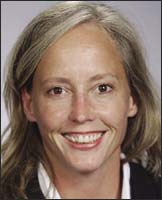 One example is 37-year-old Amy Granger, a life member of the Charlottesville-Albermarle (Va.) Rescue Squad who holds a bachelor’s degree in information systems from James Madison University. Granger, who served for 11 years on the all-volunteer rescue squad, including several years as a cardiac technician and EMT on the city’s bike rescue team, calls the work addictive. “You get to do some of the most exciting things medically and to see a side of life that most people never do,” she says. There’s just nothing like it.” One example is 37-year-old Amy Granger, a life member of the Charlottesville-Albermarle (Va.) Rescue Squad who holds a bachelor’s degree in information systems from James Madison University. Granger, who served for 11 years on the all-volunteer rescue squad, including several years as a cardiac technician and EMT on the city’s bike rescue team, calls the work addictive. “You get to do some of the most exciting things medically and to see a side of life that most people never do,” she says. There’s just nothing like it.”
Granger moved to Washington in 2002 after landing an information technology position for the Federal Reserve Board of Governors and says that she is thrilled to be an evening student at GW Law. “I’m looking forward to the intellectual challenge and to getting to know the many interesting-looking, diverse people in my classes,” she says. “I think that it’s going to be incredible.”
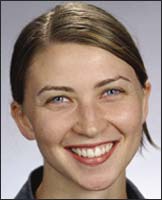 First year student Rita Siemion, a 25-year-old native of Seattle, also has devoted the past few years to helping others. After earning a bachelor’s degree in English and philosophy from Seattle University, she spent three months working as a volunteer for Mother Teresa’s Missionaries of Charity in Calcutta, India. First year student Rita Siemion, a 25-year-old native of Seattle, also has devoted the past few years to helping others. After earning a bachelor’s degree in English and philosophy from Seattle University, she spent three months working as a volunteer for Mother Teresa’s Missionaries of Charity in Calcutta, India.
“It’s something that I’ve always wanted to do,” says Siemion, who worked in an orphanage for sick, malnourished, and disabled children. “It was so rewarding to serve some of the most underprivileged people in the world.”
Upon returning to the United States, Siemion spent three years in Texas teaching high school English and working in HIV street outreach, before realizing her long-time dream of attending law school. “I’m impressed by the diversity, political activity, and level of awareness of the students at GW, as well as by the openness and helpfulness of the professors,” she says. “When I visited GW, I decided on the spot that this was the place for me.”
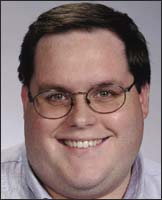 Another GW Law student who made a difference working abroad after completing his undergraduate studies is 28-year-old Jason Dutil, who has a bachelor’s degree in Russian and Eastern European Studies from Middlebury College in Vermont. Dutil spent his junior year studying in Kazakhstan, one of the former Soviet republics in central Asia, and returned to that country after graduating, landing a job in the tax field with Deloitte and Touche. “I spent four years working in the firm’s Kazakhstan office, as well as their Kiev and Ukraine offices, working on privatization deals and helping them shore up their tax departments,” he says. Another GW Law student who made a difference working abroad after completing his undergraduate studies is 28-year-old Jason Dutil, who has a bachelor’s degree in Russian and Eastern European Studies from Middlebury College in Vermont. Dutil spent his junior year studying in Kazakhstan, one of the former Soviet republics in central Asia, and returned to that country after graduating, landing a job in the tax field with Deloitte and Touche. “I spent four years working in the firm’s Kazakhstan office, as well as their Kiev and Ukraine offices, working on privatization deals and helping them shore up their tax departments,” he says.
Dutil, who also helped open the firm’s office in the Republic of Georgia, speaks Russian, Ukrainian, Kazakh, and French. Three years ago, he moved to Washington to serve as international tax services manager for Deloitte and Touche, earning a master’s degree in taxation from American University last year. He says that he’s looking forward to the challenge of law school, saying, “I crave the deep technical experience and academic stimulation. I plan to keep all the avenues open—to have a truly broad experience, and see where it leads me.”
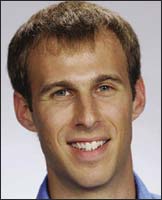 One of the many artistic members of the entering class is 27-year-old Ethan Yankowitz, who earned a bachelor’s degree in anthropology and Latin American Studies from the University of Chicago. A violinist since the age of three, the Brooklyn, N.Y., native has played with a number of community orchestras throughout the country, most recently with the Georgetown Symphony Orchestra. “I enjoy taking a break from everything else each week to perform,” says Yankowitz, who works days as a legal assistant at the National Trust for Historic Preservation. One of the many artistic members of the entering class is 27-year-old Ethan Yankowitz, who earned a bachelor’s degree in anthropology and Latin American Studies from the University of Chicago. A violinist since the age of three, the Brooklyn, N.Y., native has played with a number of community orchestras throughout the country, most recently with the Georgetown Symphony Orchestra. “I enjoy taking a break from everything else each week to perform,” says Yankowitz, who works days as a legal assistant at the National Trust for Historic Preservation.
An evening student, Yankowitz states, “I’m happy to be at GW and am looking forward to learning how the law can best be applied to both the problems and opportunities that today’s world presents us.”
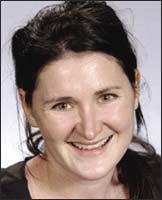 Another new law student who is no stranger to the stage is 28-year-old stand-up comedian Liz Qually, who arrived in Foggy Bottom direct from Hollywood, Calif. A Boston native, Qually spent a total of 10 years in California, earning a bachelor’s degree in political science and international development from UCLA and working behind the scenes in television and film before trying her hand at stand-up comedy. Another new law student who is no stranger to the stage is 28-year-old stand-up comedian Liz Qually, who arrived in Foggy Bottom direct from Hollywood, Calif. A Boston native, Qually spent a total of 10 years in California, earning a bachelor’s degree in political science and international development from UCLA and working behind the scenes in television and film before trying her hand at stand-up comedy.
“People have always told me that I should be a comedian,” says the vivacious Qually, who spent the past three years on the comedy circuit, performing frequently at California venues like the Comedy Store on Sunset Boulevard, as well as in Chicago, Manhattan, and other cities.
She decided that it was time for a change after realizing that the job had become “98 percent mass marketing” and had lost its luster. “I realized that I wanted to do something more meaningful,” she says. Just weeks into the academic year, Qually is thrilled with her decision to come to GW Law. “So far, it’s been super fun,” she says. “It’s such a pleasure to be working hard and learning new things every day. It’s the greatest feeling.”
Back to top | Fall 2003 Table of Contents
|